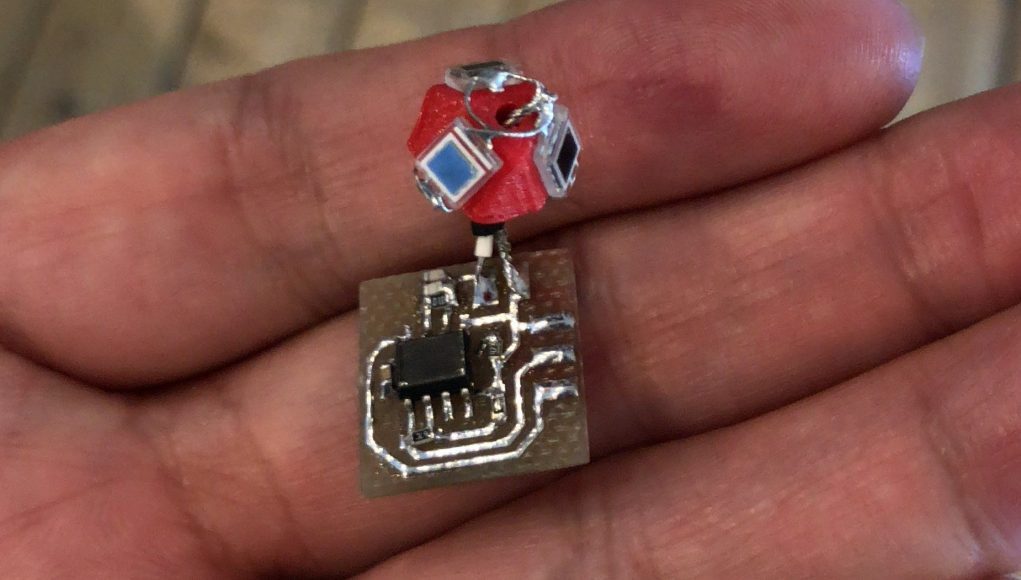Dr. Masahiko Inami, a professor at the University of Tokyo’s Research Center for Advanced Science and Technology, recently tweeted a picture of an incredibly small, homebrewed 3D-tracked sensor module that has us reeling at the implications for ever-smaller tracked objects in VR.
Update (July 10th, 2018): Project creator George Chernyshov got in contact with Road to VR to correct some items in this article.
Despite Dr. Masahiko Inami’s claim the sensor module seen in the photo above was a “Vive tracker,” Chernyshov tells us it is “indeed not a Steam VR compatible tracker by itself, just a sensor module with an amp and filters, but when attached to an xx MHz MCU that can measure time with microsecond resolution it can “know” where it is in 3d space.”
Chernyshov and Krylova’s project is partially based off hardware developer Alexander Shtuchkin’s work, which uses a Valve SteamVR base station to positionally track and autopilot a drone.
Chernyshov tells me there are a few distinctions here that separate it from a true SteamVR basestation-compatible sensor module, although a similar SteamVR basestation-compatible unit could be of comparable size:
“[I]f it is used for VR, then it would obviously require some sort of link to the computer that renders the VR scene. However the projects it was made for do not require any VR and an MCU that knows where the sensor is in 3D space is enough. But there’s no reason why a Lighthouse-compatible (note, officially not SteamVR-compatible, though I see no reason why not) tracker can’t be of a comparable size.”
Regarding the price, Chernyshov told me this: “This device can indeed be used with the Vive Lighthouse system, but with a few extra components. The price of the components in quantities we ordered was indeed below 300 JPY. The quantities were below one hundred, but still more than DIYers normally would order.”
A special thanks goes out to Bernd Kreimeier for helping with corrections to this article. I’ve replaced the words “SteamVR tracker” with “3D-tracked sensor module” to better reflect the critical distinction listed above.
A corrected version of the original article, which was first published June 6th, follows below:
Measuring about the size of a single AirPod earphone, Dr. Inami says the 3D-tracked sensor module only cost ¥300 in parts, or around $2.70 USD to make.
すごい、vive trackerの自作レシーバー。部品代300円だって! pic.twitter.com/teyDMbgNz5
— 稲見昌彦 Masahiko Inami (@drinami) July 3, 2018
The mini sensor module seems to lack a battery, which would noticeably increase the size (see update above). As an engineering feat though, it shows just how small things can get when dealing with SteamVR tracking sensors—the lightweight, low power, low-cost ASIC sensors that can be used to receive lasers emitted from SteamVR tacking basestations.
Valve provides royalty free access to its sensors, and can be purchased from a number of part suppliers on their own.
SteamVR supports up to 32 sensors for a single object; as you would imagine, the higher the sensors on a single object, the greater 360 coverage you’ll have. HTC’s own Vive Tracker contains 23 sensors for 360 degree coverage. The mini 3D-tracked sensor’s three sensor nodes are likely a bare minimum for basic tracking, and we wouldn’t expect something that small to be nearly as robust as the consumer Vive Tracker mentioned above.
It’s certainly a cool way to illustrate just how little you might need to create your own mini 3D sensor with the requisite parts.
For users looking to jump into SteamVR hardware hacking, a company called Virtual Builds is offering a full SteamVR tracker kit, which includes everything you need to create your own SteamVR 2.0 tracker.







